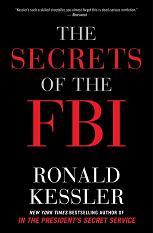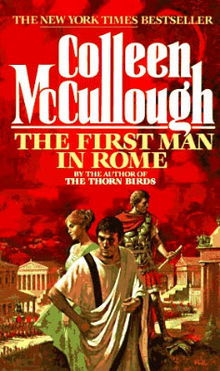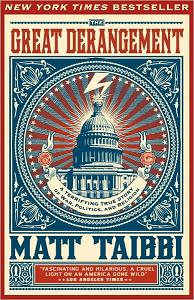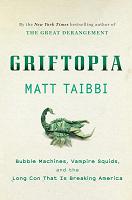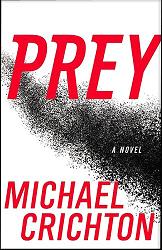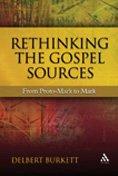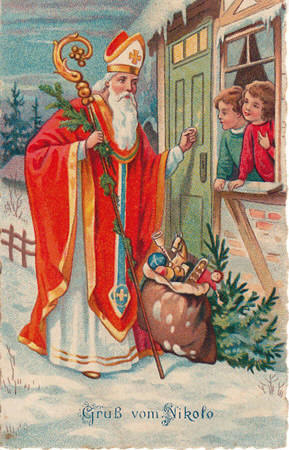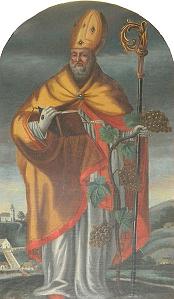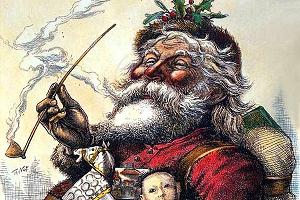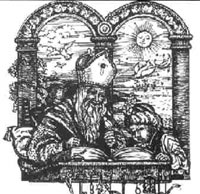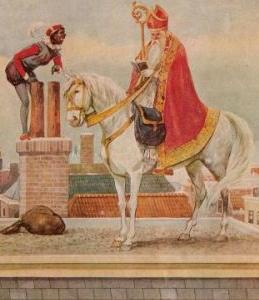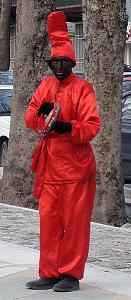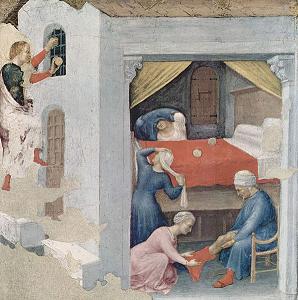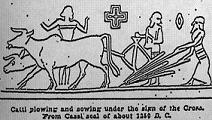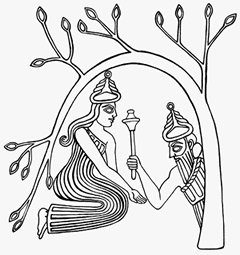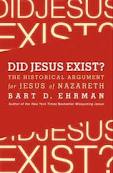
After far too many years, finally a book has come out by a worthwhile Biblical scholar that attempts to address the Christ-Myth hypothesis that the gospels are actually a fictional narrative and that a first century Jesus did not actually exist. Bart Ehrman’s “Did Jesus Exist?” is credited as a “master explainer with deep knowledge of the field” who “methodically demolishes both the scholarly and popular “mythicist” arguments against he existence of Jesus” according to the jacket. Many other mythicist critics have taken up a retort to this book, but when I finally got a hold of it myself (thanks, Niels), I knew I had to go through it myself and show exactly how “deep” his knowledge really is. Although I consider myself a mythicist, I do believe there was a historical Jesus, though I believe he lived in the first century B.C. However, I usually very much enjoy reading books by Biblical scholars who argue for the first century Jesus and definitely believe they typically offer far better commentary on the origin of Christian literature. I also have another book of Ehrman’s, Lost Christianities, which I thoroughly enjoyed. I sometimes read things I disagree with but I typically find them to entirely reasonable nevertheless. Very rarely have I encountered even one “howler” that just completely misses the mark altogether. Not so with this book. Every page in this book is filled with errors, misconceptions, and straw men arguments. If it wasn’t for his characteristic tendency of lionizing Biblical scholars who pour over details with all-important linguistic “tools” unavailable to the amateur, it would be hard to believe the same person wrote this book. It definitely has the feel of a book being written quickly. Here is much of what he wrote:
“THERE is no need for me to give a comprehensive history of the claim that Jesus never existed. I will simply say a few words about some for he most important representatives… Some of the other mythicists I will mention throughout the study include Richard Carrier, who along with Price is the only mythicist to my knowledge with a graduate training in a relevant field (Ph.D. in classics from Columbia University)…” (14-19)
Despite his modesty, Ehrman does a decent job going over the history of mythicism. He even manages to remember Bruno Bauer. The only two people I would’ve liked to have added are the Swedish linguist Alvar Ellegard, who wrote Jesus: One Hundred Years Before Christ. and G. R. S. Mead. Ellegard also wrote A Statistical Method for Determining Authorship managed to identify the anonymous 18th-century political writer known by the pseudonym Junius as Sir Phillip Francis by electronically comparing the content of the letters to 230,000 words taken from known works.
“Eleusinian mysteries focused on the godman Dionysus (18, 22). [Not true. These mysteries were not about Dionysus but about the goddess Demeter.] (28)
Dionysus is the son of Demeter, and just as with other dying and rising gods like Dumuzi and Adonis, they were heavily associated with an older goddess figure. Sophocles names the god of the mysteries at Eleusis as both Bacchos (Dionysus) and Iacchos (called the “third Dionysus” by Nonnus) in Antigone. A song to Dionysus from Delphi describes Iacchos at Eleusis, where he “brings salvation.” During the festival, the first row of initiates swung tree branches called bacchoi and the second row were led by a torch-bearing priest named after Iacchos. There’s a whole category of Dionysian mysteries that ancient religion scholars are well aware of.
“Many early Christians rejected Mark’s Gospel as noncanonical (146). [Actually, Mark was everywhere accepted as canonical; in fact, every surviving Christian document that refers to it accepts it canonicity.] (29)
That’s not saying much since the earliest mention of a gospel comes from about 110 years after Jesus’ reported death, and even that is small amount and only from documents the surviving church sought to hold on to. The footnote explains that they are talking about how Papias was defensive about Mark not being an eyewitness and that the “Oracles of Matthew” was the most popular gospel at the time. Many scholars also question whether Papias’ Mark is the canonical Mark, but they take that for granted. Technically speaking, there wasn’t even a New Testament canon until about 180, so really their mistake is using the word “canonical” instead of “authentic” and thereby mistakenly implying an early canon, which is pretty much the exact opposite of underplaying Mark’s canonical status.
“The original version of Mark “did not include the resurrection at all” (156). [Not true. The original version of Mark does not have an episode in which Jesus appears to his disciples after the resurrection, but the text is completely unambiguous that Jesus had been raised from the dead. See example, Mark 16:6, which was an original part of the Gospel.] (29)
Let’s look at the full statement from the book: “The original version of the Gospel of Mark, the earliest account of the Jesus story, did not have the resurrection at all. This had been added later. Before these additions, Mark’s gospel ended with the women finding the empty tomb and only the intimation that Jesus had been resurrected as promised.” So is Ehrman’s complaint here that an “intimation” is “ambiguous”? No, he would have included the full quote in that case. This is the work of someone who is deliberately taking a statement out of context to score cheap points correcting mistakes that aren’t there.
“The Romans “completely destroyed the state of Judea in II2 CE” (178). [This is a bizarre claim. There was not even a war between Rome and Judea in 112 CE; there were no wars between Rome and Judea in II2; there were wars in 66-70 and 132-35 CE.]” (30)
Actually there were three wars, the second being the Kitom war, starting in 115 (close enough). The revolt broke out centered Lydda and spread out to recently conquered cities with large Jewish populations until Cyrene, Cyprus, Mesopotamia and Aegyptus joined in the revolt. Eusebius reports that Libya was depopulated to such an extent that new colonies had to be established within a few years. Gamaliel II died during the siege of Lydda.
“To begin with, there is no hard, physical evidence for Jesus (eighteen hundred years before photography was invented), including no archaeological evidence of any kind. This is not much of an argument against his existence, however, since there is no archaeological evidence for anyone else living in Palestine in Jesus’s day except for the very upper-crust elite aristocrats, how are occasionally mentioned in inscriptions (we have no other archaeological evidence even for any of these)… And absolutely no one thinks that Jesus was an upper-class aristocrat. So why would we have archaeological evidence of his existence?…” (42-43)
I don’t know any mythicist who has argued that there should be archaeological evidence for Jesus, but if he had marched into Jerusalem and tried to take over the Temple as all four gospels attest, the action would have been historically important enough to describe in War of the Jews, Philo and Justus of Tiberias.
“At the same time, the fact is again a bit irrelevant since these same sources do not mention many millions of people who actually did live… Moreover, it is an error to argue, as is sometimes done by one mythicist or another, that anyone as spectacular as Jesus allegedly was, who did so many miracles and fantastic deeds, would certainly have been discussed or at least mentioned in pagan sources if he really did exist. Surely anyone who could heal the sick, cast out demons, walk on water, feed the multitudes with only a few loaves, and raise the dead would be talked about! The reason this line of reasoning is in error is that we are not asking whether Jesus really did miracles and, if so, why they (and he) are not mentioned by pagan sources. We are asking whether Jesus of Nazareth actually existed. Only after establishing that he did exist can we go on to ask if he did miracles.” (44)
I don’t know of any mythicists who believe that if Jesus was historical that he would be doing any miracles. As Ehrman points out later, they are mostly agnostics and atheists.
“What archaeological evidence do we have about Pilate’s rule in Palestine? We have some coins that were issued during his reign (one would not expect coins about Jesus since he didn’t issue any, and one—only one—fragmentary inscription discovered in Caesarea Maritima in 1961 that indicates that he was the Roman prefect. Nothing else… He certainly existed even though, like Jesus, we have no records from his day or writings from his hand… Think of an analogy. If a historian sixty years from now where to write up a history of the American South, in say, the twentieth and twenty-first centuries, is he likely to mention Zlatko Plese? (Zlatko is my brilliant colleague who teachers courses in ancient philosophy, Gnosticism, arieties of early Christianity, and other subjects.) Almost certainly not. What does that prove? Technically speaking, it proves nothing. But it does suggest that either Zlatko never existed or that he did not make a huge impact on the political, social, or cultural life of the South. As it turns out, Zlatko does exist (I bought him dinner last night)…” (44-45)
Is Ehrman being paid per word?
“If he is rarely mentioned, it is barely relevant to the question of his existence. It is possible that he simply made too little impact, just like the overwhelming mass of people who lived in the Roman Empire of the first century.” (46)
If Ehrmna believes the Testimonium is authentic, then it means Josephus considered the death of Jesus to be a “sad calamity” that “put the Jews into disorder,” comparable to two massacres he just listed. Jesus can’t be both highly irrelevant and a national tragedy.
“First, some (such as G. A. Wells) have maintained that if one moves the entire Testimonium from its larger context, the preceding paragraph and the one that follows flow together quite nicely.” (61)
It’s not just that.
“The pared-down version of Josephus—the one that others have thought was original, without the Chrsitian additions—contains very little that could have been used by the early Christian writes to defend Jesus and his followers from attacks by pagan intellectuals. It is a very neutral statement. The fact that Jesus is said to have been wise or to have done great deeds would not go far in the repertoire of the Christian apologists.” (62)
It isn’t neutral at all. He’s called “a wise man” and a “doer of starling deeds, a teacher of people who receive the truth with pleasure.” This in a book of failed Messiahs that Josephus heaps nothing but scorn upon. Wells and others have pointed out that Origen referenced “James, the brother of Jesus” three times as proof of how “wondrous” it was that, even though Josephus did not accept Jesus as Christ, he still reported how the “justice of James was not at all small.”
“But it needs to be stressed that in the possibly original form of Testimonium there is not a word about Jesus being a messiah figure or even a political leader. He is simply a teacher with followers, accused on unknown grounds by (specifically) Jewish leaders and then executed.” (63)
But why? If Jesus had keep executed for causing a disturbance at the Jerusalem Temple, that would have been the most famous thing about him. Yet the Testimonium doesn’t even give a reason for his death. The writings of Josephus are long and descriptive, and in every other Jewish-Roman conflict, he elaborates on why the things that happen go about.
“Moreover, if one reads the passage without the rose-tinted lenses of the Christian tradition, its view of Jesus can be seen as basically negative” (63).
What?!? I would not believe Ehrman was familiar with the minimized Testimonium if he did not quote it himself in his book. Jesus is “a wise man” who teaches people “who receive the truth with pleasure,” who maintained followers both Jewish and Greek that “loved him” and “did not cease to do so” even after his execution . This is negative?!?
“The fact that he was opposed by the leaders of the Jewish people would no doubt have shown that he was not an upright Jew. And the fact that he was condemned to crucifixion, the most horrific execution imaginable to a Roman audience, speaks for itself. Even though Jesus may have been a good teacher, he was a threat to the state, or at least a nuisance, and so the state dealt with him fairly and strongly, by condemning him” (63).
Ehrman is basically describing what Josephus should have said if the minimized Testimonium were real. The fact that it does not has forced Ehrman to dismiss its obviously glowingly positive words as meaningless and instead he decides to accuse the atheist Earl Doherty of reading it with the “rose-tinted lenses of the Christian tradition.” This is pure projection. Ehrman must at least subconsciously realize that a negative reading of Josephus would help the “Christian tradition” and so is trying to get points for being neutral by claiming that an “unbiased” reading of Josephus has him praising the Pharisees and the Romans for “fairly” executing a wise, truthful, inclusive, and beloved teacher for no particular reason. Obviously, he feels forced to do this because he knows that Josephus normally would find a reason to defend both the Pharisees and the Romans.
“Doherty also objects to the idea that Josephus could call Jesus “wise” and one who appears to have taught the “truth.” If Josephus knew the teachings of Jesus—with which he surely would have vehemently disagreed—then he never could say such things. To this it can easily be objected on one hand that there is no reason for thinking that Josephus knew any of the things Jesus taught, and on the other that many of the things Jesus taught were in fact what many other famous teachers of Judaism taught: for example, that followers of God should love God above all else; that they should love their neighbors as themselves; that they should do good unto others; that they should feed the hungry and care for the poor and oppressed; and well, lots of other things that have seemed through the ages to Christian believer and unbeliever as both wise and true.” (63)
If Josephus knew nothing about Jesus’ teachings, then why would he call them wise and truthful? Wanting to defend both the Pharisees and the Romans, he would have simply assumed his teachings were the same as every other zealot he despises. What was Jesus, a Galilean peasant, doing with a large group of followers in Jerusalem, throwing out the merchants at the Temple? How could Josephus possibly justify such actions without some sort of authority that the Gospels claim Jesus completely refused to give: “Neither will I tell you by what authority I am doing these things” (Mark 11:33). But if that isn’t ridiculous enough, Ehrman opens up the other possibility that Josephus could have accepted Jesus’ teachings of love and universal brotherhood while at the same defended his execution!
“Those who wrote apocryphal stories about Jesus are flamboyant both in what they relate (recounting lots of Jesus’ miracles, for example) and in how they say it (stressing his divine nature, not simply that he was the messiah). The Testimonium is so restrained, with only a couple of fairly reserved sentences here and there, that it does not read like a Christian apocryphal account of Jesus written for the occasion.” (65)
Restrained? Even the minimized Testimonium includes mention of wondrous works. Apparently, Ehrman believes that all Christian interpolators would be unable to attempt a forgery of Josephus without recounting “lots of Jesus’ miracles” and not leave any possible doubt with the reader that Jesus is divine. My interpretation of the Testimonium is the exact opposite. I think there are two interpolators of Josephus here: one that did a very bad job of imitating Josephus’ attitude towards someone like Jesus (the minimized Testimonium) and another doing a mind-numbingly terrible job imitating Josephus’ attitude towards someone like Jesus (the full Testimonium).
“Recent estimates suggest that there were possibly up to a million Jews living in Palestine at any one time in the early first century… Josephus does not mention 99 percent of them—or rather, more than 99 percent. So why would he mention Jesus? You cannot say that he would have mentioned Jesus because anyone who did all those amazing miraculous deeds would surely be mentioned. As I pointed out earlier, the question of what Jesus actually did has to come after we establish that he lived, not before.” (66)
No, it should be argued at the same time. Ehrman seems to suggest that the most historically likely subject historians would comment on is Jesus’ miracles. Obviously, even if the historical Jesus did perform miracles, they were in front of his believers and not in the middle of the streets of Jerusalem. But Ehrman agrees with the gospels that Jesus was executed for causing a disturbance at the Jerusalem Temple, which obviously would have distinguished him from the other 99% of Palestinians. Yet Ehrman keeps trying to make the point that Jesus was no more historically remarkable than every other Galilean peasant who didn’t bring large crowds of people on a suicide mission. That is what Josephus should have talked about if he was describing a historical Jesus. Again, I don’t know any mythicists who argue his miracles should have been mentioned. I get the feeling that Ehrman is really talking to his literalist readers rather than the mythicists he is supposedly arguing against.
“In other references in the Talmud we learn that Jeus was a sorcerer who acquired black magic in Egypt. Recall the Gospel accounts of how Jesus fled his family to Egypt soon after his birth and his abilities later in life to perform miracles. He is said in the Talmud to have gathered five disciples and to have been hanged on the eve of Passover, after a herald proclaiming the charges of sorcery against him for forty days. Here again we may have a biased version of the Gospel accounts, where Jesus is killed during the Passover but with injudicious speed after a very quick trial, his execution occurring some twelve hours after his arrest.” (67)
Ehrman forgets to mention that Jesus is said to have lived in the first century B.C., was a student of Yehoshua ben Perachiah, that his mother was a hairfresser, that he was stoned to death, and then hung on a tree. Also, the account of him going to Egypt has a completely different context. These any many other details have nothing in common with the Gospels.
“The Talmudic references to Jesus were written hundreds of years after he would have lived and so are really of very little use for us in our quest.” (68)
This is typical of Christian studies scholars only accepting Greek-written writings of Jesus as “useful.” The writings about Jesus from his own people are deemed worthless and derivative without any explanation other than it is late. But in fact, Tertullian makes a reference to the story element about people stomping on cabbages on the way to see Jesus’ hung body proves that the story was in existence by the turn of the third century. The first Talmudic writings making reference to Jesus comes from the Mishnah, which was collected in the 200s, not long after the first references to Luke and John (Luke being the first gospel that is an unabashed attempt at history-writing). The names the Talmud gives for five disciples do not appear to be mythological constructions, at least not as much as “Twin, the twin of Jesus,” “Simon the Zealot” and “Judas Iscariot (the Sicarii).” In Mark 8:19-21, Jesus tells his disciples that five loaves fed five thousand with twelve left over and that seven loaves fed four thousand with seven left over, emphasizing the numerical symbolizism by asking them for the numbers and then telling them: “Do you not understand?” The five loaves are meant to symbolize the five disciples of Yeshu feeding five thousand in the Jerusalem church with their words, leaving twelve apostles left over. The seven loaves represent the seven evangelists who are denigrated as “table-waiters” in Acts 6:1-6 and who feed the four thousand Grecian Jews with their words, presumably leaving seven more evangelists in their place. One version of the Toledot also speaks of twelve men from the first century B.C. who wandered the “twelve kingdoms” of Israel and “spread false doctrines,” which when added to “the Twelve” from the gospels makes twenty-four, the same number of “prophets” who Jesus’ disciples say had “spoken in Israel” about Jesus in the Gospel of Thomas. (Robert Funk of the Jesus Seminar interprets “twenty-four prophets” to mean the number of books in the Jewish canon, but that would insinuate one prophet per book, which is not how the canon is set up.)
“These Talmudic references to Jesus were written hundreds of years after he would have lived and so are really little use for us in our quest. By the time they were set down, and every single Christian telling stories about Jesus naturally assumed that he had really existed as a historical person.” (68)
This leaves me to believe Ehrman has not actually read of the Talmudic writings since he obviously believes they confirm his first century A.D. dating.
“What [Luke] heard may have been right or it may have been wrong, but the fact that later Christians long after he was dead placed his book into the canon of the New Testament has nothing to do with it. Luke’s writings about Jesus carry no more or less weight than the writings of any other ancient biographer (Seutonius, for example, or Plutarch) –or, perhaps a more apt comparison, of any other biographer of a religious person, such as Philostratus and his account of Apollonius of Tyana.” (74)
Unlike Mark’s “folktale” and Matthew’s “romance,” Luke is writing an “epic history” rather than a story. But he is clearly working under the aegis of religious apologetics, which is different than both the history-writing of Seutonius or the story-writing of Plutarch. Simply comparing the Paul of Acts to the Paul of the epistles shows that Luke is purposely saying the exact opposite of what his sources are telling him, such as James and Cephas agreeing with Paul on the question of eating kosher foods when it is clear from Galatians that they did not. Luke’s biases are much larger, more particularized, more fantastical, and far, far more reactionary than other historians of his time. Historians like Seutonius, Plutarch and Philostratus were writing for a large and diverse audience while Luke was writing for one particular sect of a very unpopular religion. Luke’s readers almost by definition already agreed with him, so the author had far more creative control over explaining what “really” happened. Josephus may reiterate a few mythical stories as history, but gospel episodes like the apostles meeting with Simon Magus are obviously invented by Luke himself for theological purposes. In this way, I believe Luke is far more dishonest an author than Mark or Matthew. Like the Gospel of John, Luke shows a particular alliance to the Ephesus Presbyters (Acts 20:17-38), who are largely responsible for making the disbelief in the historical first century Jesus a heresy.
“These Gospels were probably written ten or fifteen years after Mark, and so by the year 80 or 85 we have at least three independent accounts of Jesus’ life (since the number of accounts of both Matthew and Luke re independent of Mark), all within a generation or so of Jesus himself, assuming he lived… Prior to the narrative leading up to Jesus’ death, most of the stories in John are found only in John, whereas John does not include most of the stories found in the other three Gospels” (76)
The likelihood of authenticity is increased when different sources from different backgrounds agree on the details of narrative, not when different sources from the same background disagree on the details of a narrative. Most scholars do not believe anything in John is historical and I do not remember Ehrman ever mentioning anything in John that he thought is.
“It is equally true of John’s account of Jesus’s death.” (76)
Where did this account of the Passion supposedly come from seeing how the disciples ran away upon his arrest? Did John get an interview with Pontius Pilate?
“The same can be said of the Gospel of Peter…” (77)
The Gospel of Peter is nothing except a Passion narrative, complete with a fictional courtroom of Jewish judges where Pilate and Herod presided over together! Crossan and Koester believe it was the original Passion source for the canonical gospels, and everyone else believes is completely derivative of the canonical gospels. In either case, it is not an independent account that Jesus lived. Also, a study by Crossan has shown that the original version of the Gospel of Peter had Jesus sentenced solely by the Sanhedrin and executed by the people rather than by Roman soldiers, matching the description of Jesus’ death in the Talmud and the Toledot.
“There are protracted debates among scholars about how much material from the life of Jesus this account originally contained.” (77)
Protracted debates about the historicity of a Passion narrative– from an apocryphal gospel– that none of Jesus’ disciples witnessed? Where?
“Another independent account occurs in the highly fragmentary text called Papyrus Egerton 2. Here again it is difficult to know how extensive the full Gospel contained in these partial remains originally was; what survives are four episodes from the life of Jesus, one of which has no parallel in the Gospels of the New Testament or in any other known Gospel. Here then, at least in the nonparalleled story, but probably in all four, is a seventh independent account.” (77)
So because of three garbled sentences about one unreadable miracle on the Jordan River, we have another “independent account”? Why not count the other two versions of Mark that have a different ending? Why not count the version of Luke that has Jesus crying tears of blood and the version of John with the story of Jesus helping the prostitute? It seems any tiny spelling variation of a Greek gospel could warrant an “independent account.” Yet the Talmudic references, which show far more variability in content not derived from the Greek tradition, is dismissed out of hand. The Toeldot Yeshu is not even mentioned. Those are too “late” to be historically worthy, so their traditions are derivative on the gospels even though most of the details show no similarity at all to the gospel tradition.
“But if we restrict ourselves here, as we did earlier, to a hundred years after the traditional date of Jesus’s death, we have at least seven independent accounts, some of them quite extensive.” (78).
The dating of the gospels are based mostly on the assumption that Jesus lived when the gospels say he lived, so it is somewhat circular logic to assume the canonical gospels are more trustworthy than other material like the Talmud or the Toledot based on a first century dating that is not based on outside evidence. There is actually some good evidence all four gospels should be dated to the second century, such as the lack of synagogues and Bible-beating Pharisees in the small towns of Galilee until after the Bar Kochba Revolt. The second century Rabbi Jonathan, when questioned about healing on the Sabbath, is quoted as saying: “For it is holy unto you, I.e., [the Sabbath] is committed to your hands, not you to its hands.” (Mark 2:27). So it appears the gospels (as we have them) could be retrojecting the second century into the first century. Admittedly, there is a lot in Mark that seems to suggest it was written during or shortly after the First Jewish-Roman war in 70 A.D., but a lot of those verses could equally be attributed to the next two wars in the second century. The parts of the gospel narrative that point to the first century, such as John the Baptist, Pontius Pilate, the names of the twelve disciples and the curtain of the Temple ripping, could have come from earlier sources than the canonical gospels or were simply meant as callback to the First Jewish-Roman war in order to parallel one of the more current wars in the second century.
“We cannot think of the early Christian Gospels as going back to a solitary source that “invented” the idea that there was a man Jesus. The view that Jesus existed is found in multiple independent sources that must have been circulating throughout various regions of the Roman Empire in the decades before the Gospels that survive were produced.” (82)
Just because some gospels have different stories than other Gospels does not mean that the entire “Gospel as biography” genre must have been re-created from scratch in every instance. As Ehrman himself says just a little bit later: “And some stories were made up in the process, developed to speak to the needs the Christian communities and to address the situations they found themselves in” (84). Why then, could the gospel genre not have been invented for exactly that same reason?
“Yet many of them, independent though they be, agree on many of the basic aspects of Jesus’s life and death: he was a Jewish teacher of Palestine who was crucified on order of Pontius Pilate, for example.” (86)
There are also different accounts that claim Zoroaster lived, but they disagree by as much as 5,000 years. Is Ehrman just as sure that Zoroaster was a historical person? Is every version of the King Arthur story also an “independent account” that Arthur lived and was a king? John the Baptist and Pontius Pilate were famous figures who could easily have been added to the gospel narrative to symbolize the beginning and ending of the Jewish Messianic movement from baptism to defeat to “resurrection.” The story of Jesus changing water to wine parallels the structure of the gospel, beginning with a baptism by John, a stand-in for their Essene origin, and a Eucharist, signifying his death under Pilate, a stand-in for the Roman power. In contrast, the connections Yeshu has between Yehoshua ben Perachiah and Shimeon ben Shetach in the Jewish tradition, are more arbitrary and therefore more realistic in my opinion.
“These oral traditions had been in circulation for a very long time before they came to be written down. This is not pure speculation. Aspects of the surviving stories of Jesus found in the written Gospels, themselves based on earlier written accounts, show clearly both that they were based on oral traditions (as Luke himself indicates) and that these traditions had been around for a very long time—in fact, that they had been around since Christianity first emerged as a religion in Palestine itself.” (86).
Many of the gospel stories and teachings do appear to have come from oral tradition, but for how long is hard to tell. The biographical details, however, such as where Jesus was born (Nazareth of Bethlehem?), when Jesus was born (4 B.C. or 6 A.D.?), and to how many parents (Joseph and Mary or just Mary?) are too varied to be historically reliable. Some of the details appear to be based on theological reasons: a prophecy about Bethlehem, the census as a symbol of Roman dominion, etc.
“In several passages in the Gospels a key word of phrase has been left in the original Aramaic, and the author, writing in Greek, has had to translate it for his audience.” (87)
Knowing a phrase in Aramaic hardly proves that it was originally written in that language. Time and time again, various scholars have embarked on the crusade to find the Holy Grail of an early Aramaic Proto-gospel, yet they have been repeatedly struck down time and time again and have never gone much further than identifying a few Semitisms in Q. If the core of the Gospels is the Greek Cynicism of the wisdom sayings, then it is perhaps time to consider the possibility of a Hellenistic origin.
“Mark is not the only Gospel where this occurs… They approach him and say to him “Rabbi,” an Aramaic word that the author translates “which means, ‘Teacher.’” (88)
Is Ehrman insinuating that the story in John was originally written in Aramaic because it translates the word “Rabbi”? The first person to called Rabbi in the Talmud is Gamaliel the Elder, who lived 20 years after Jesus died. The term was not used to mean a common teacher until the advent of the synagogue, which archaeology suggests was no built en masse until after the Bar Kochba Revolt.
“There is very little dispute that some of the Gospel stories originated in Aramaic and that therefore they go back to the earliest stages of the Christian movement in Palestine.” (88)
I don’t think so. Every Biblical scholar I’ve read treats the idea like something from the past.
“AT THE OUTSET I should emphatically state the obvious. Every single source that mentions Jesus up until the eighteenth century assumed that he actually existed. That is true no matter what period you choose to examine: the Reformation, the Renaissance, the Middle Ages, Late Antiquiuty, and before. It is true of every author of every kind, Christian, Jewish, or pagan… The idea that Jesus did not exist is a modern notion. It has no ancient precedents. It was made up in the eighteenth century. One mnight well call it a modern myth, the myth of the mythical Jesus.” (96).
The Talmud and the Toledot say Jesus lived during the first century B.C. If we look past primary sources and include references to people who reportedly did not believe in a historical Jesus, there are also the Gnostic “anti-Christs” in 2 Peter and 2 John who were always “refusing to acknowledge Jesus Christ as coming in human nature” and claiming the gospels were “cleverly invented myths.” Justin’s Trypho says: “if he has indeed been born and exists anywhere—is unknown…” Mara Bar Serapion dated the “wise king” who was executed by the Jews (not the Romans) as happeneing immediately before the Hasmonian kingdom fell. Epiphanius also accidentally endorsed a legend that Jesus was crowned king after Alexander Jannaeus. There are also the Docetics, who believed Jesus had not been born but rather had come down in the spirit and did not have a physical body and who were, as I see it, responsible for the parts in Luke and John where Jesus manages to escape the crowds by moving directly through them. The Manicheans also did not accept that Jesus had a physical body. The Cathars held a similar belief up until Albingesian Crusade. The 12th century Spanish philosopher, physician, and historian, Abraham ben Daud also recorded in his “The Jewish history-writers say that Joshua ben Perachiah was the teacher of Yeshu ha-Notzri, according to which the latter lived in the day of King Janni…”, as recorded in Dr. Adolph Neubauer’s Medieval Jewish Chronicles from 1887.
“What I did not stress earlier but need to point out now is that there is absolutely nothing to suggest that the pagan Tacitus or the Jewish Josephus acquired their information about Jesus by reading the Gospels. Indirectly, then, Tacitus and (possibly) Josephus provide independent attestation to Jesus’s existence from outside the Gospels although, as I stated earlier, in doing so they do not give us information that is unavailable in our other sources.” (97)
Tacitus mistakenly refers to Pilate as a procurator, a title that only came into use after the year 44, and the same mistake as the gospels. The sources from the gospels all come from the same Christian background so obviously the views of Josephus and Tacitus are more important than yet another version of the gospel which we well know there must have been hundreds of. Had Tacitus called Pilate by his rightful title rather than the title used by the gospel tradition, it would prove that he received his information from a source independent of the gospel narrative, and would be have been strong evidence for a first century Jesus.
“Papias may pass on some legendary traditions about Jesus, but he is quite specific—and there is no reason to think he is telling a bald-faced lie—that he knows people who knew the apostles (or the apostles’ companions). This is not eyewitness testimony to the life of Jesus, but it is getting very close to that.” (101).
Ehrman himself points out that Papias lived in the second century and wrote his book some time between 120 and 130. Assuming the average scholarly dating for the Pauline epistles, that means that he would have been talking to apostles such as Paul or Apollos 70 to 80 years after their prime. Disciples of Jesus would have to have been living 90 to 100 years after Jesus died. Hence, even with Irenaeus moving Jesus’ death to the 50s A.D., the Apostolic tradition still needed to paint John as a young man during the time of Jesus and an extremely old man when he supposedly taught Papias and Polycarp, who then relayed the Apostolic canon and tradition to Irenaeus so that he could write about it around 180. That’s 150 years for only two degrees of separation.
“The ones I am most interested in here, however are those that oppose Christians who insisted that Jesus was not a real flesh-and-blood human. These opponents of Ignatius were not ancient equivalents of our modern-day mythicists. They certainly did not believe that Jesus had been made up or invented based on the dying and rising gods supposedly worshipped in this world and delivered inspired teachings. But he was God on earth, not made of flesh as the rest of us.” (102)
We do not have the actual writings of any Docetics so as to be completely sure how grounded in history their angelic Savior was, but one thing Docetics and mythicists definitely had in common is their belief that Jesus was not “born of woman.” If 2 Peter was written against the Docetics as some have argued, then they definitely did believe that those who believed in a historical Jesus did “follow cleverly devised myths” (1:16). 2 John is written against the same “anti-christs.”
“First from a letter that Ignatius wrote… For you are fully convinced about our Lord, that he was truly from the family of David according to the flesh, Son of God according to the will and power of God, truly born from a virgin, and baptized by John that all righteousness might be fulfilled by him. In the time of Pontius Pilate and the tetrarch Herod, he was truly nailed for us in the flesh… Ignatius, then, provides us yet with another independent witness to the life of Jesus.” (102-103).
Just as with 2 Peter and 2 John, the fact that the epistles of Ignatius are so aggressively reactionary proves that there was an ancient belief that Jesus was not from David, not baptized by John, and not killed by Pontius Pilate. The author would hardly need to forcefully pound in that Jesus “truly” baptized by John and crucified during the time of Pontius Pilate and the tetrarch if the only point of conflict between him and his detractors was whether Jesus had a physical body or not. (Notice that it is not “under Pilate” but “In the time of Pontius Pilate and the tetrarch Herod,” indicating that perhaps Ignatius knows only the Gospel of Peter’s Passion narrative of Jesus being judged by both Pilate and Herod.) A real independent witness would not just defend the status quo of the literal interpretation of the gospel narrative but add secondary knowledge: something like the location of where Mary or some of the disciples are buried. It would only make sense to someone trying to provide compelling evidence for the historicity of Jesus.
“The letter of I Clement… His sufferings were “before your eyes” (2.1)… The blood of Christ is precious to the Father, poured out for salvation (7.4)… The blood of the Lord brought redemption (12.7)… Jesus came from Jacob “according to the flesh” (32.2)… Everyone knew he existed.” (104-105).
If everyone knew he existed, that reality would be evident from detailed post-gospel events about Jesus’ family and disciples, not vague theological declarations against supposedly non-existent arguments on whether or not Jesus was born “according to the flesh.” Clement fails even to identify the name of Jesus’ mother despite his obvious desire to convince the reader that Jesus was a historical person. Since Clement obviously was not writing to direct witnesses of the crucifixion, it can safely be presumed that the sufferings “before your eyes” were metaphorical. And blood being “poured for salvation” and “redemption” does not prove anything about a historical Jesus.
“There are reasons for thinking that at the heart of both stories is a historical tradition: independently they confirm that a field in Jerusalem was connected in some way both with the oney Judas was paid to betray Jesus and with Judas’s death. Moreover, it was known as the Field of Blood“ (108)
If Ehrman hadn’t summarily dismissed the Jewish tradition of Jesus without even reading it, he would know that the Toledot identifies Judas as a gardener and that it was in his field where Jesus was hung on a vegetable stalk after being stoned to death in the first century B.C. Judas then stole the body (which is probably related to what Matthew was referring to when he spoke of a “rumor” that the disciples stole the body) and hid it in his own garden. There is also another parallel in John where Mary Magdalene mistakes the gardener for Jesus, which appears to be connected to the fact that the gardener Judas is the “twin” of Jesus, confirming that he is mythologically equivalent to Judas Thomas. Since it is well known that there is a Gnostic tradition in which Judas is crucified in place of Jesus, we can see how the garden might have also become connected to Judas’ own death on a tree takes the place of the older legend of Jesus being hung on a tree, his suicide symbolizing how the actions of the Zealots and Sicarii in Jerusalem ultimately brought about their own deaths and the destruction of Jerusalem.
“Moreover, that Luke has access to sayings of the historical Jesus not recorded otherwise, even in his Gospel, is clear from a passage as Acts 20:35, where the apostle Paul is recorded as saying, “I have shown you that it is necessary be hard work to help the weak, and to remember the words of the Lord Jesus, that he said ‘it is more blessed to give than to receive.’”… Whether Paul himself really knew this saying of Jesus can be argued. But what is clear is that Luke thinks he knew it, and, more importantly for our considerations, that it is a tradition of a saying of Jesus that has no parallel in any of our Gospels. And so the book of Acts provides further evidence from outside the Gospels that Christians from earliest times believed that Jesus actually lived, as a Jew, that he was a moral teacher, and that he was killed in Jerusalem after being betrayed by one of his own followers, Judas.” (108-109).
How is a second work by one of the evangelists “further proof” of anything? Acts 20:35 could easily be a poetic reference to Luke 6:34: “If you lend to those from whom you hope to receive, what credit is that to you?” or 18:22: “Sell all that you own and distribute the money to the poor, and you will have treasure in heaven.” Even if it was a unique tradition, there are plenty of unique traditions from Luke. What would it matter whether he placed it in his gospel or put it in the mouth of Paul in Acts?
“But the speeches in Acts are particularly notable because… it shows that Acts is not simply a document from the 80s CE.” (109)
What evidence is there that Luke predates Marcion’s gospel in the 130s or even that it existed before the 170s? Luke says that while Jesus speaking in a synagogue in Nazareth, he makes a reference to healings in Capernaum in 4:23 before actually going there in 4:31, a strange editorial mistake that makes it was appear the story was originally meant for a later part of the gospel. Tertullian, in Against Marcion 4.7, quotes the beginning of Marcion’s gospel as a composite of Luke 3:1a and 4:31, proving that Marcion’s gospel began with Jesus in Capernaum before Nazareth. This indicates that Marcion’s version was closer to the original.
“That the speeches of Acts contain very ancient material, much earlier than the Gospels, is significant as well because these speeches are completely unambiguous that Jesus was a mortal who lived on earth and was crucified under Pontius Pilate at Jewish insistence. Consider the following extracts from three of the significant speeches” (112)
What evidence is there that these speeches were written long before the Gospels? Acts 13 appears to be the beginning of a source focusing on the “prophets and teachers” (not apostles) of Antioch, including “Saul” (It’s the Ephesus tradition that renamed him “Paul”). Luke refers to Antioch 14 times and says that it is the first place where people started calling themselves Christian (11:26). The Epistle to the Galatians refers to Peter going to Antioch and the Gospel of Matthew, which sets up Peter as the “cornerstone” of the Church has also been linked to Antioch by several story elements including the amount of a certain tax that’s mentioned. This also seems to fit with Luke’s sources since the first speech is attributed to Peter and both Luke and John have a special affinity with Peter despite the fact that John is the predominate apostle in the Ephesus tradition. Luke dedicates his gospel to a Theophilus and there was a Theophilus who became the Patriarch of Antioch in 169, who also happens to have written about the etymology of the name Christian, which curiously enough, is not named after Jesus but “because we are anointed with the oil of God” (emphasis mine). Polycarp is also known to have been in communication with Ignatius of Antioch. The “we” passages which are connected to the ship faring adventures of Paul in the second half of Acts would more likely to have come from a Pauline sect of Christianity hostile to Judaism, an adequate description of the Marcion sect. Thus, the sources of Acts point largely to its composition in the second century.
“Among the writings that circulated under the name of Paul are a number that Paul did not actually write. One of them is the letter of I Timothy, which records the tradition known from so many of our other sources: “I command you before the God who makes all things alive and Christ Jesus, the one who, bearing his testimony before Pontius Pilate made the good confession…” (113-114)
1 Timothy does not show up until Irenaeus’ canon from 180, along with 2 Peter and 2 John, which as we have already established, were written specifically to contradict the “non-existent” idea that Jesus was a myth.
“Peter too probably did not write either book that bears his name in the New Testament… For you were called to this end, because Christ suffered for you, leaving an example for you that you might follow in his steps, who did not commit sin, nor was deceit found in his mouth, who when reviled did not revile in return, while suffering uttered no threat, but trusted the one who judges righteously, who bore out sins in his body on the tree, in order that dying to sin we might live to righteousness, for by his wounds we were healed (3:21-24).”… Once again we have independent testimony to the life (in the flesh) of Jesus and his very tangible death” (114)
Ehrman obviously has not read very much material from any mythicists since he does not seem to understand that Jesus being hung on a tree, just like Adonis and Yeshu, is a central argument of the mythicists. Apparently he thinks he can easily make a point just by running through the Bible and finding any reference to Jesus’ death whether it’s on a Roman cross or not.
“Even the book of Revelation, with all its bizarre imagery and fantastic apocalyptic views, understands that Jesus was a real historical figure. For this author he was one who “lived” and who “died” (1:18).” (115-116)
So he “lived” and “died”… as opposed to “dying and rising” gods?!? Again, Ehrman does not seem to understand what he is arguing against. Let’s look at that verse he mentioned: “I am the first and the last, and the living one. I was dead, and see, I am alive forever and ever; and I have the keys of Death and of Hades.” If this verse is proof of Jesus as a historical first century peasant, what exactly would Ehrman consider to be proof of an originally divine “dying and rising” god?
“As my final example I can turn to the letter of the Hebrews… He was descended from the tribe of Judah (7:14)”… He suffered “outside the gate” (that is, outside Jerusalem; 13:12)” (116-117).
After over 100 pages, Ehrman has finally made a decent point. Doherty has argued that the Jesus of Hebrews is mythical, saying that being descended from Judah is based on Psalm 110 and that “outside the gate” refers to the Levitical lamb being sacrificed “outside the camp” modeled after Exodus. I disagree with that assessment. Nevertheless, since this book is supposedly a reaction against mythicists, it would have been nice for Ehrman had included that interpretation himself instead of implicitly assuming there are no mythicist arguments for it. In my opinion the Epistles to the Hebrews was written by the same Proto-Orthodox group in Antioch who did know the gospel narrative and were responsible for rewriting the “Pauline” epistles of Marcion so that they included very Hellenistic interpretations of the Old Testament.
“First, Paul indicates unequivocally that Jesus really was born, as a human, and that in his human existence he was a Jew. This he states in Galatians 4:4: “But when the fullness of time came, God sent his son, born from a woman, born under the law, that he might redeem those who were under the law…” (119)
Dying and rising gods were typically demi-gods born from a human woman and hung on a tree. The author of Galatians could have taken a story about Yeshu being born without a father and hung on a tree and applied those parallel motifs to the standard dying and rising god myth. Christian studies scholars very often have a hard time appreciating how radical it would have been to nominate a recently living peasant for being one with the Godhead, even in a Hellenistic Jewish culture. Caesar Augustus himself got criticized for taking divine titles during his lifetime. Crossan makes a good attempt at explaining this elevation of early Christianity as an ironic (satiric?) reaction to Augustus’ titles implying divine right by conquest by bestowing the same titles on Jesus by the divine right of peace, a compelling idea that nevertheless has little scriptural evidence to back it up. More common in Jewish religion were abstract spiritual concepts such as the Enochian Son of Man or the Greek Logos. Combining such ideas with a vague myth from over a century ago would be a lot less problematic than identifying it with a recent teacher. And had the author of Galatians been even somewhat familiar with the gospel Jesus, he surely would have mentioned his mother Mary or his “disciples” (a word he never uses). Instead, Cephas and James are only “apostles,” no better connected to Jesus than him.
“This statement also indicates that Jesus’ mission was to Jews, a point borne out in another letter of Paul’s, in Romans 15:8: “For I say that Christ became a servant to the circumcised to show the truthfulness of God, in order to confirm that promises given to the patraichs.” (119).
Neither of those verses speaks of any mission. The redemption Jesus gave was through his death, not his teachings, as anyone familiar with the Pauline epistles can explain. The grammar of the passage in Romans is temporally ambiguous. NRSV translates the passage: “Christ has become a servant of the circumcised”, meaning this is probably referring to another vision, just as in 1 Cor. 9:1: “Have I not seen Jesus our Lord?” Being a “servant to the circumcised” does not quite exemplify his missionary work in the gospels.
“…the phrase Jesus Christ, which means “Jesus the messiah” (since the Greek word Christ is a literal translation of the Hebrew word messiah)…” (119).
As if his complete disregard for any arguments made by actual mythicists had not already proved Ehrman is not writing this book as part of any honest discussion on the topic, this sentence pretty much nails it in the head that it is just meant as a hit job to sell books to Bible illiterates who haven’t even figured out that Christ and Messiah are the same thing.
“Do we not have the right to take along a believing wife as do the other apostles and the brothers of the Lord and Cephas?” It should not be thought here that Paul is referring to “brothers of the Lord” in some kind of spiritual sense, in that in Christ all men are brothers. If that were what he meant, then the rest of the statement would make no sense because it would mean that the apostles themselves and even Cephas (Peter) were not the “spritual brothers” of the Lord since they are differentiated from those who are brothers.” And so interpreters are virtually unified in thinking that Paul means Jesus’ actual brothers (120).
The differentiation is that the apostles and Cephas are itinerant “messengers” who traveled and that the “brother of the Lord” is the spiritual leader of the Jerusalem Church. Had James been an actual physical brother of Jesus, or Cephas been an actual disciple of Jesus, then it would be unthinkable that the author could so boastfully dismiss their opinions and equate his authority as equal to theirs as he does in Galatians, at least not without explaining himself. Even someone getting his information from visions would have a hard time telling Jesus’ own disciples what it means to be a follower of Jesus. And why would he know the name of Jesus’ brother but not his mother? If the “brothers of the Lord” was a euphemism for spiritual brotherhood, or if they were descendants of Yeshu, then it could easily be seen how he was able to dismiss James so lightly.
“We know the names of some of Jesus’s brothers from our early Gospel traditions. The Gospel of Mark names them as James, Joses, Judas, and Simon (6:3). It also indicates that Jesus had sisters, though these are not named.” (120)
The verse referring to those names of Jesus’ brothers is not exactly a completely arbitrary biographical detail given for the sake of the reader’s knowledge. Had that been the author’s intention, it would say something like: “Jesus’ family lived in Nazareth: his brothers were James, Joses, Simon and Judas, and his sisters were Salome and Ruth.” Instead, the names are given as part of the story. His own hometown takes offense to him, asking, “Is not this the carpenter, the son of Mary and brother of James and Joses and Judas and Simon, and are not his sisters here with us?” And so Jesus declares that prophets have no honor in their hometown. Given the context, we might consider a symbolic interpretation in which Jesus is not accepted among his own people because they already had figures like him with those names. In fact, the names of Jesus’ brothers do reflect famous Jews from first century Galilee. Judas the Galiliean was a zealot, and his “sons” (or disciples) were James and Simon. Joses the Galilean was a famous rainmaking sage who could control the weather, much like Jesus and Honi the Circle Drawer. The reason Jesus’ sisters have no names can be explained by the fact that there were no famous women personages in Galilean history during this time. Luke uses the same symbolism in his version of the story, but makes a stronger emphasis on the present fact that the Jews had not accepted Jesus as the Messiah.
“As it turned out, in one place Paul also names one of the brothers of Jesus, and it is none other than James, also mentioned by Mark” (120).
But Galatians also refers to “James, Cephas, and John,” which one can only presume is supposed to refer to the same big three disciples in the gospels: Peter, James and John. If James is the brother of Jesus, how can he also be James, son of Zebedee? And why is James the leader of the Jerusalem church and not Peter? Acts only confuses things more by having James the leader of the Jerusalem chruch get killed and then presumably another James appears as leader of the Jerusalem church without any explanation!
“The fact that Paul speaks of “the twelve” as having seen Jesus at the resurrection means either that he does not know the stories about Judas (as was probably true of Mark and John as well) or, as I have suggeseted, that the name “the twelve” was attached to this group as a group, even when one of them was no longer with them.” (121)
If Paul really spoke to the brother of Jesus, shouldn’t he know everything about Judas?
“What this means, then, is that Paul believes that it was the Jews (or Judeans) who were ultimately responsible for killing Jesus, a view shared by the writers of the Gospels as well, even though it does not sit well with those of us today who are outraged by the wicked use to which such views were put in the history of anti-Semitism… He never mentions Pontius Pilate or the Romans, but he may have had no need to do so. His readers knew full well what he was talking about. Crucifixion was the form of punishment used by the Romans and could be used on criminals sentenced by Roman authorities.” (124-125).
Again, Ehrman does not even seem to be aware that the word for “crucifixion” is the same for “staked” as in “staked to a tree.” This is one of the central pillars of the mythicist argument yet he shows know knowledge of it.
“G. A. Wells argues that what we have here in Paul is not a quotation of the historical Jesus but a prophecy from heaven that came to a Chrsitain prophet, which Paul understood, then, as having come “from the Lord.” (126)
Hey, Ehrman finally brought up a second argument from a mythicist in his book about mythicists.
“It looks exceedingly likely that Paul is basing his exhortation on a tradition about divorce that he knows—or thinks he knows—going back to the historical Jesus… we have close parallels beween what Paul says Jesus said (in a quotation or a paraphrase) and what Jesus is recorded elsewhere as having actually said.” (127)
Marriage was actually rather rare among the ancient Jesus movements. The Marcionites did not marry. The Cerinthians did not marry. The Montanists did not marry. The Nicolaitans, the Gnostics of Asia Minor and the Carpocratians were all said to have ruled out having children although they did have intercourse, according to Epiphanius. Even the formerly “Proto-Orthodox” Tatian, who combined the four canonical gospels into a super-gospel, became a “heretic” over a religious disagreement over whether marriage was permitted, a split that made him leader of many ascetic “Encratites” in Syria. Papias’ Ephesus church in Asia Minor appears to have been bucked tradition by not just allowing marriage but only allowing married men to become “elders.” Yet even an apocryphal Acts of Paul and Thecla from a dissident in that same church makes the claim that Paul preached complete asceticism as the only means of converting. That dissident was defrocked for it, according to Tertullian. Most of the other sects are known to have used different versions of the gospels, and the ascentic Marcionites had a shorter version of the Pauline Epistles. Did all of them edit out that part Jesus and Paul said about marriage?
“He is writing these letters to deal with problems that had arisen in [his churches]. His letters are not meant to spell out everything that he knew or thought about God, Christ, the Spirit, the church, the human condition, and so forth. He addressed problems that his churches were facing. I myself have written hundreds of lketters dealing with religious issues over the past thirty-five years. It would be, oh, so easy to collect seven of these letters and not find a single saying of Jesus quoted or a single reference to anything he is thought to have done or experienced” (129-130).
It is true that most letters would not expound on these things. That is one of the reasons I think even the primary Pauline epistles are fake, because in fact, the Pauline epistles DO spell out tons of things about God, Christ, the Spirit, the church, the human condition, and things that one would have expected him to have already explained to his readers. It is because Paul does not say everything he should say if he had something like the gospel narrative in mind that it feels “incomplete” to those who read the gospels first.
“I should stress that the Pauline scholars who have devoted many years of their lives to studying Romans and Galatians and I Corinthians are not the ones who argue that Paul never mentioned the details of Jesus’s life—that he as born of a woman, as a Jew, and a descendant of David; that he ministered to Jews, had a last meal at night, and delivered several important teachings. It is only the mythicists, who have a vested interest in claiming that Paul did not know of a historical Jesus, who insist that these passages were not originally in Paul’s writings. One always needs to consider the source.” (133)
So people who devote their lives to Jesus and the Bible do not have any vested interest a historical Jesus? Ehrman admits to once being an evangelical that took a literalist approach to the Bible. So was the Biblical scholar and theologian Robert Price, who also says he thought the idea was crazy until he really started looking into it.
“As I earlier mentioned, the author of 1, 2, and 3 John was living in the same community out of which the Gospel of John was produced, and he shows clear evidence of actually knowing John’s Gospel. And how many times does he quote it in his three letters? None at all.” (137-138)
John’s epistles are very short (supposedly to “save ink”) and there’s no way to know if the epistles didn’t come before the Gospel. Also, it’s possible the author of 2 John would just be quoting himself.
“How often does he talk about Jesus’s parables, his miracles, his exorcisms, his trip to Jerusalem, his trial before Pilate? Never. Does that mean he doesn’t think Jesus lived?” (138)
The first two Johannine epistles were written only to “prove” that the gospel Jesus had come in the “flesh” and was therefore a historical person. None of the parables, miracles, etc., needed to be repeated because it was already assumed the reader was familiar with the gospel narrative that the author intended to validate. The third epistle appears to have only been written to give authority to a presbyter named Diotrephes.
“So too with the book of Acts.” (138)
Since the author of Acts already included Jesus’ sayings in his gospel, which he assumed had already been read, repeating those sayings would be redundant. Yet despite this redundancy, Luke actually does have Peter explain “how God anointed Jesus of Nazereth with the Holy Spirit and with power; how he went about doing good and healing all who were oppressed by the devil, for God was with him. We are witnesses to all that he did both in Judea and in Jerusalem” (10:38). This is the point that the Pauline epistles never make: that a historical Jesus had lived and had conducted an itinerant ministry recently. Notice that Luke emphasizes the fact that Peter claims to have witnessed the acts directly, a point he would hardly had to justify to the reader since it was already assumed, yet he needed to make the point clear to counteract the “anti-christs” in 2 Peter who said the stories of Jesus were “myths.”
“The authors of I Clement (from around 95 CE) and the Epistle of Barnabas (around 135 CE) show clear and compelling evidence that they know about Jesus and understand that he was a real historical figure. They say a number of things about him. But their silences are nearly as large as those of Paul.” (138)
That’s the exact same point Earl Doherty makes in his book which Ehrman obviously didn’t bother reading. The silence is not just in Paul but in all the early epistles, proving that the idea of historical first century Jesus is late.
“They do not show that these authors did not know about the historical Jesus, because they clearly did.” (139)
Oh. Well, no needed for any evidence to that effect, then.
“One, obviously, is that Paul didn’t say more about the historical Jesus because he didn’t know much more. This strikes many readers as implausible: if he worshipped Jesus as Lord, surely he wanted to know more about him. Wouldn’t he want to know absolutely everything about him? It may seem so. But it is important to remember that when Christians today think of their faith, they often think about the ultimate source of their faith in the New Testament, which begins with the Gospels that describe the things Jesus said and did. And so for Christians today, it only makes sense that a Christian is informed about Jesus’s life. But when Paul was writing there were no Gospels. They were written later. It is not clear how important the details of Jesus’s life were to Paul.” (139)
First off, the epistles are first spoken about as being canonized by Marcion in the second century, so despite their nearly universal dating to the first century (largely assumed because of the epistles’ low Christology), we do not actually know for sure that there were no gospels at the time. But Paul would hardly need the gospels to know about the life of Jesus. Second, if Jesus had only lived 20 years prior, there should have been plenty of information about him from James or Peter or “acknowledged leaders,” yet as we’ve seen in Galatians, what they said “makes no difference to me; God shows no partiality” (2:6).
“And Paul could scarcely have thought that Jesus died if he hadn’t lived.” (140)
Oh, right. Mythicists must have just forgotten about that one. I guess that means Dionysus, Adonis, Attis, etc. must have been historical people too.
To be continued….


